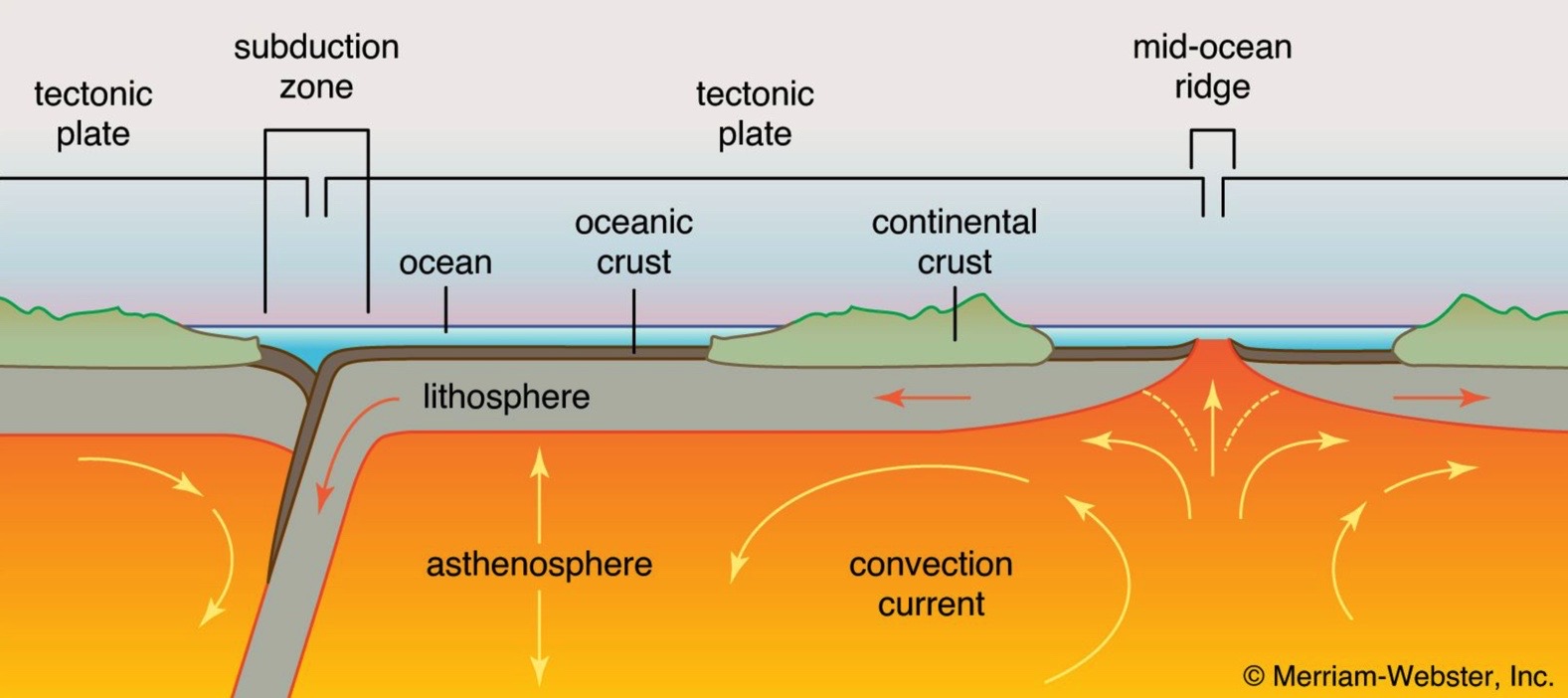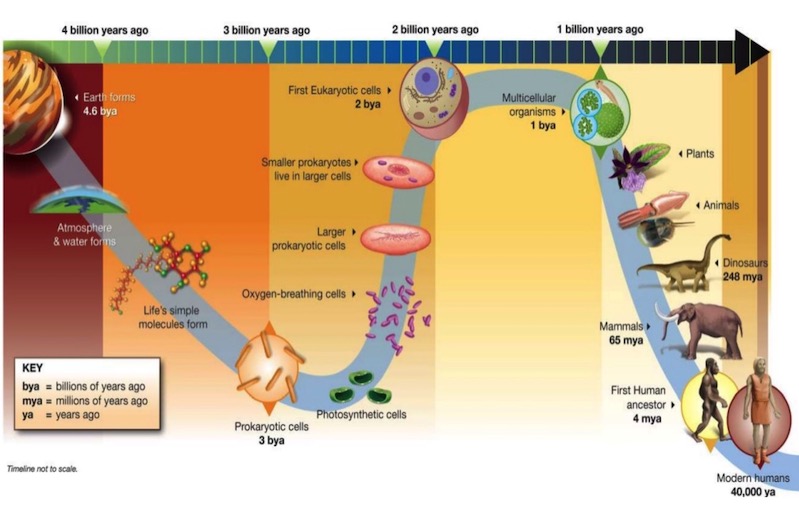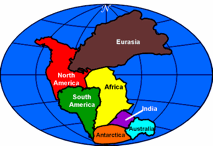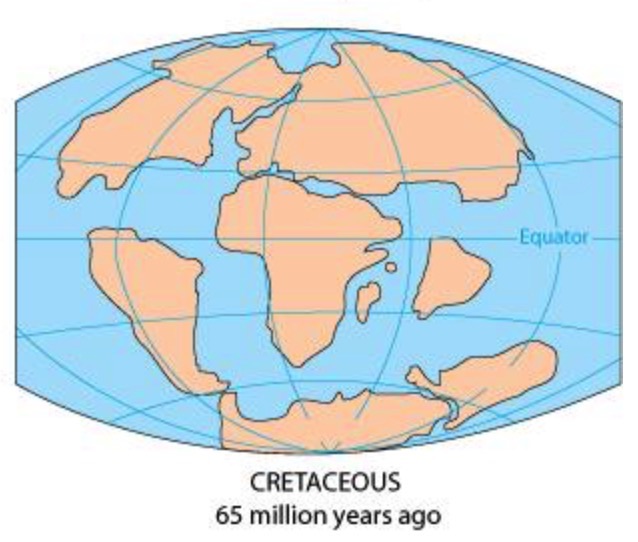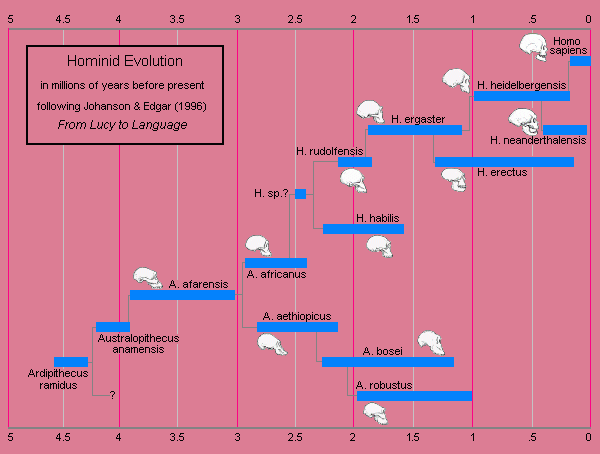In response, I moved the first sections HERE.
Though brief, they still makes for a quick introduction to Creation and the start of life on earth.
(Jan. 2024)
15,000 Mya: Big Bang !


15,000 Mya: Beginning of our Universe
![]() - Note: all dates are best estimates !
- Note: all dates are best estimates !
4,500 Mya: Our Sun and planets coalesce
Initially, our solar system was a cloud of dust and gas drifting in space. Eventually, gravity caused this matter to coalesce into clumps; the smaller ones orbiting around the largest which would become the sun. Smaller clumps would become planets, moons and asteroids.
Another effect of gravity was to draw the heavier elements, like metals, closer to the sun while gases stayed further out. As a result the inner planets (Mercury, Venus, Earth and Mars) are similar with a silicate (rock) shell around an iron core while the 4 outer planets (Jupiter to Neptune) are gas giants made primarily of hydrogen and helium.
As the new planets grew, they attracted tons of drifting matter which crashed into their surface. The energy from impacts created enough heat to melt the new planets which only became solid much later as they cooled. Our moon is thought be the result of such a crash of a Mars-sized meteor into our molten Earth; the debris then recombining to create our moon.
Eventually, Earth cooled enough for a thin crust to form on the surface; and later, when the surface cooled below 100°C, water from the atmosphere could rain down and form the oceans.
Currently, our Earth is far from being a solid rock with natural activity limited to the surface; rather it is a complex onion structure with a solid iron core surrounded by alternating solid and molten layers. The temperature around the core is about 6000°C, close to that of the sun's surface. And our continents are merely the last layer, the crust: 60km thick rafts of rock floating on the surface. We normally think of stones and mountains as heavy; but, the crust composed mainly of silicon oxides is light enough to float on the metallic layers below.
A look inside
3,500 Mya: Continents appear
As shown below, the earth's crust, floating on a molten layer below, is not smooth; over time, it developped high spots, called tectonic plates, from volcanic activity as a shrinking core. Surrounded by oceans, the highest part of the plates became the continents.Continents started appearing around 3 billion years ago and moved around on a swirling mantle. Around 300 million years ago, 6 continents coalesced into a single super-continent called Pangea where terrestrial life began. A bit later, around 200 Mya, Pangea sp;it into the 5 continents we know today.
Life begins
3,000 Mya: Primitive cells (prokariotes) develop in waterthen : Photosynthetic cells start producing oxygen
For the next 3 billion years, life remains in the form of increasingly complex single cells living in the ocean, such as: bacteria, protozoa and amoebas
References
1,000 Mya: Multicellular Life
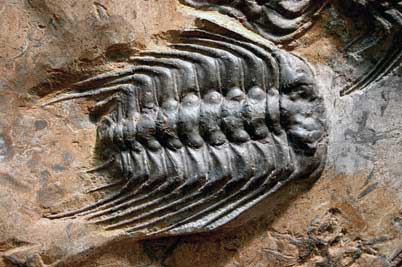
Trilobite
1,000 Mya: Appearance of first complex
organisms like algae,
![]() sponges and coral
sponges and coral
300 Mya:
Drifting continents coalesce into a single land mass: Pangea
250 Mya: ![]() MASS Extinction clears the way for the appearance of Dinosaurs
MASS Extinction clears the way for the appearance of Dinosaurs
250 - 65 Mya:
Age of Dinosaurs ( Mesozoic Era )
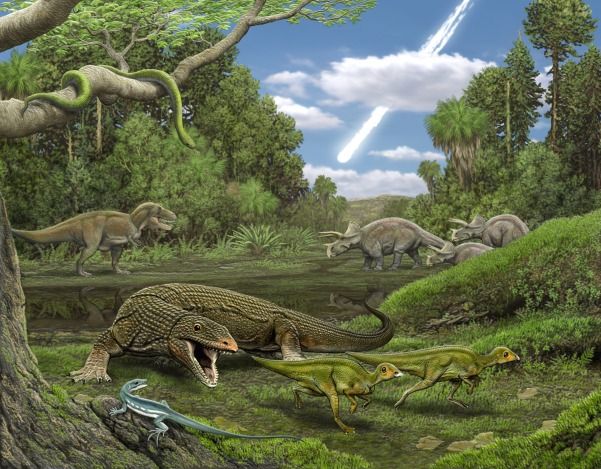
Ref: Live Science

![]()

![]()

![]()

Pictures from G. Rymill -
150
Mya: Plants develop FLOWERS
135
Mya: First mammal (small mouse)

100 Mya: Mammals take over
- 65 Mya:
Current theory is that a massive asteroid impact filled the atmosphere with dust shutting out sunlight. This lead to a nuclear winter and mass extinction. A 110 mile wide crater off the coast of Yucatan is thought to have been the site of impact.
- Mammals - who have the advantage of being warm-blooded - survive and proliferate
- 60
Mya: First primates (lemurs)
- 50
Mya: First horses
- 40
Mya: First monkeys
- 15
Mya: Great apes diverge from monkeys
North America and Greenland are still attached to
Eurasia.
South America is isolated and India is floating towards Asia.
5 MYa: First Hominins
Man's ancestors, known as Hominins [ previously called hominids ], diverge from chimps and start appearing in Africa around 5 Mya. Changes in going from Monkey to Man include:
- Loss of tail
- Hip changes to promote Bipedal locomotion
- Loss of tree-life attributes: arms shorten and prehensile toe disappears
- Larger brain and smaller jaw changes the skull shape [see REF]
Hominins evolve through a dozen species before Homo Sapiens [Modern Man] appears.
